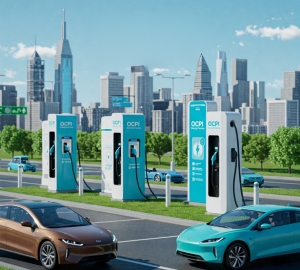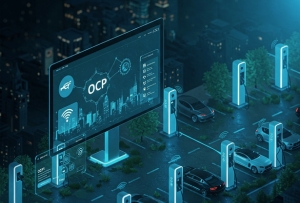Experion is at the forefront of technological innovation, continuously pushing the boundaries to create smarter and more efficient solutions. As the world transitions towards a sustainable future, electric vehicles (EVs) are gaining traction at an unprecedented pace. However, the rapid expansion of EV adoption demands a seamless and interoperable charging infrastructure to ensure a frictionless experience for users. Recognizing the importance of open standards in shaping the future of e-mobility, Experion actively supports and promotes the adoption of the Open Charge Point Interface (OCPI). By embracing OCPI, Experion aims to drive interoperability, scalability, and efficiency in EV charging networks, enabling seamless communication between charging point operators (CPOs) and mobility service providers (MSPs). This commitment to open and standardized solutions empowers businesses, enhances user experiences, and accelerates the widespread adoption of electric mobility worldwide.
What is Open Charge Point Interface (OCPI) Protocol?

The Open Charge Point Interface (OCPI) protocol is an open standard developed to facilitate seamless and transparent communication between different electric vehicle (EV) charging networks. As the EV ecosystem continues to expand, interoperability among various charging networks has become essential for improving the charging experience for users. OCPI ensures that Charging Point Operators (CPOs) and Mobility Service Providers (MSPs) can efficiently exchange crucial information, such as charging station availability, pricing, authentication, and billing details. By enabling cross-network compatibility, OCPI removes the barriers that often arise due to proprietary systems, fostering a more interconnected and accessible EV charging infrastructure.
History and Development of OCPI
The OCPI protocol was initially developed by the Netherlands’ EV industry to address the growing need for standardized communication among different EV charging networks. With the expansion of electric mobility, it became clear that a common language was needed to bridge the gap between various CPOs and MSPs.
Over time, OCPI has evolved significantly, with multiple versions being released to enhance its functionality. Early iterations of OCPI focused primarily on basic interoperability and communication, while later updates introduced advanced features such as:
- Smart charging – optimizing charging sessions based on grid conditions.
- Tariff transparency – providing clear pricing structures across networks.
- Real-time session management – enabling users to track and manage their charging sessions remotely.
Today, OCPI is widely accepted and implemented by many key players in the EV charging ecosystem, making it one of the leading standards for open communication in e-mobility.
Importance of Open Standards in EV Charging Infrastructure
The rapid expansion of EV infrastructure demands open and standardized communication protocols to ensure a seamless and efficient charging experience. OCPI plays a vital role in this landscape by enabling different networks to work together, fostering a more user-friendly and scalable charging ecosystem.
Key Advantages of Open Standards like OCPI
Interoperability
- Open standards like OCPI eliminate the challenge of fragmentation in the EV charging space by ensuring that different networks and service providers can communicate effortlessly.
- This means EV drivers are no longer restricted to a single network but can use multiple charging stations without facing compatibility issues.
Scalability
- As EV adoption grows, the charging network must scale accordingly. Proprietary solutions often create bottlenecks and limit expansion, whereas OCPI provides a flexible and future-proof foundation for growth.
- OCPI allows businesses to integrate new stations into their networks without requiring extensive infrastructure overhauls.
Flexibility
- OCPI supports diverse business models, payment systems, and regulatory requirements, making it adaptable to different regional and operational needs.
- It enables features such as EV roaming, where drivers can charge their vehicles on multiple networks using a single payment or subscription service.
Enhanced User Experience
- With OCPI, EV drivers gain access to real-time charging station availability, transparent pricing, and seamless authentication, leading to a more convenient and efficient charging experience.
- It reduces range anxiety and enhances confidence in public charging infrastructure.
Encourages Innovation and Collaboration
- Open protocols like OCPI allow companies to collaborate rather than compete over proprietary systems, ultimately accelerating the advancement of the EV industry.
- Businesses can integrate new features, adopt emerging technologies, and ensure compatibility with the latest developments in smart charging and energy management.
The Open Charge Point Interface (OCPI) protocol is a game-changer in the EV industry, enabling widespread connectivity, efficient communication, and a frictionless charging experience for both providers and users. By supporting open standards, the industry can ensure that EV adoption continues to grow without the hindrances of fragmentation or exclusivity.
Key Features of the OCPI Protocol

The Open Charge Point Interface (OCPI) protocol is a leading open standard that facilitates seamless communication between different EV charging networks. What sets OCPI apart from other protocols is its comprehensive feature set, ensuring that EV drivers, Charging Point Operators (CPOs), and Mobility Service Providers (MSPs) can interact efficiently.
- Interoperability: Bridging the Gap Between Networks
One of the most significant challenges in the EV charging ecosystem is fragmentation—where different charging networks operate in isolation, creating inconvenience for EV drivers. OCPI solves this by enabling cross-network communication, ensuring that:
- EV drivers can charge their vehicles on any compatible charging station, regardless of the operator.
- CPOs and MSPs can exchange information about charging station availability, pricing, and authentication in real-time.
- Roaming agreements between multiple networks become seamless, allowing drivers to access a broader network without additional registrations or complex payment processes.
This level of interoperability greatly improves user experience and removes the hassle of being restricted to a single provider’s charging infrastructure.
- Scalability: A Future-Proof Protocol for Growing EV Demand
As EV adoption accelerates worldwide, charging infrastructure must scale accordingly. OCPI is designed with scalability in mind, ensuring that:
- CPOs can expand their networks without worrying about compatibility issues, allowing new charging stations to be integrated seamlessly.
- The protocol supports an increasing number of EV users and charge sessions without significant modifications.
- It allows multiple service providers to collaborate, reducing costs and enhancing efficiency.
With OCPI, networks can grow organically and dynamically, ensuring that the charging ecosystem remains robust and capable of handling the expected surge in EV usage.
- Flexibility: Enabling Various Use Cases in the EV Charging Ecosystem
The OCPI protocol is not limited to a single functionality—it supports diverse use cases that enhance the charging experience for both operators and end-users. Key functionalities include:
- Roaming: EV drivers can charge their vehicles across different networks using a single subscription or payment method.
- Tariff Integration: OCPI enables transparent pricing structures, allowing users to view and compare real-time tariffs across different providers.
- Smart Charging: The protocol supports advanced energy management, ensuring that charging is optimized based on electricity demand, pricing fluctuations, and grid conditions.
- Payment Flexibility: Supports multiple payment methods, allowing seamless transactions between networks and reducing the need for multiple accounts.
This flexibility ensures that both CPOs and MSPs can tailor their services to meet the evolving needs of EV drivers and the energy grid.
- Security: Protecting Data Integrity and User Authentication
Given the critical role of data exchange in EV charging networks, security is a fundamental requirement. OCPI implements robust authentication and authorization mechanisms to protect:
- User Data: Ensures that sensitive information, such as payment details and personal user data, remains encrypted and secure.
- Network Communications: Protects against unauthorized access, ensuring that only authenticated service providers and operators can exchange data.
- Session Integrity: Ensures that charging sessions are monitored and cannot be altered fraudulently, reducing risks of billing discrepancies or unauthorized usage.
By prioritizing security, OCPI fosters trust among stakeholders and ensures that EV drivers and businesses can rely on the network without concerns about data breaches or fraud.
- Standardized Communication: Ensuring Consistency Across Platforms
A major advantage of OCPI is that it provides a standardized communication framework that enables different charging networks and service providers to work together seamlessly. This standardization ensures:
- A consistent exchange of information regardless of network provider, charging station model, or backend system.
- Reduced complexity for developers and operators, as they do not need to build custom integrations for every new network.
- Faster adoption of new technologies, as OCPI remains adaptable to future industry advancements.
With a standardized approach, businesses can focus on innovation rather than integration challenges, accelerating the growth of the EV ecosystem.
Comparison with Other EV Charging Protocols
While OCPI is a key component in the EV charging ecosystem, it is often compared with other widely used protocols such as Open Charge Point Protocol (OCPP) and ISO 15118. Each protocol serves a different purpose, and understanding their distinctions is crucial.
OCPI vs. OCPP: Understanding Their Roles
| Feature | OCPI | OCPP |
| Purpose | Manages communication between CPOs and MSPs to enable interoperability between different networks. | Manages communication between EV chargers and their backend management systems. |
| Primary Focus | Interoperability, roaming, and data exchange between different networks. | Ensuring that charging stations can be remotely controlled and monitored. |
| Use Case | Enables EV drivers to charge their vehicles across different networks seamlessly. | Allows operators to manage charging stations, including firmware updates and load balancing. |
| Scalability | Designed to support growing networks and facilitate seamless expansion. | Focuses more on managing individual chargers within a network. |
OCPI is essential for enabling EV roaming and network interoperability, while OCPP is focused on communication between charging stations and backend systems. Both protocols complement each other rather than compete.
OCPI vs. ISO 15118: The Smart Charging Protocol
ISO 15118 is another significant protocol in the EV charging ecosystem. It is primarily focused on Vehicle-to-Grid (V2G) communication, allowing EVs to communicate directly with the charging station and the power grid.
| Feature | OCPI | ISO 15118 |
| Purpose | Enables seamless network-to-network communication for interoperability. | Enables direct communication between the EV and the charging station. |
| Key Use Case | Ensuring that charging networks share real-time data and allow roaming. | Facilitating smart charging, bidirectional power flow, and automated plug-and-charge experiences. |
| User Experience | Improves roaming and network accessibility for EV drivers. | Enhances automation with plug-and-charge capabilities and V2G interactions. |
While OCPI focuses on interoperability between networks, ISO 15118 enables direct communication between EVs and charging stations, making it essential for smart charging and V2G applications.
How the Open Charge Point Interface (OCPI) Protocol Works

The Open Charge Point Interface (OCPI) protocol operates through a well-defined architecture that enables seamless and secure data exchange between Charging Point Operators (CPOs) and Mobility Service Providers (MSPs). By facilitating efficient communication, OCPI ensures that EV drivers have real-time access to charging networks, pricing, and session management, ultimately improving the overall charging experience.
OCPI functions through a set of modular components, each responsible for handling specific tasks such as session tracking, authentication, pricing, and network management. These modules work together to create an interoperable and scalable EV charging ecosystem, removing barriers that arise due to proprietary systems and enabling efficient cross-network interactions.
Key Modules in OCPI
- Session Management: Real-Time Charging Session Tracking
The Session Management module plays a crucial role in monitoring and managing active charging sessions. It provides real-time updates on the following parameters:
- Charging status: Whether the session is ongoing, paused, or completed.
- Energy consumption: Live tracking of the amount of electricity consumed during a charging session.
- Session termination: Ensures that sessions are properly ended to prevent billing discrepancies and unauthorized use.
This module enhances transparency and accuracy for both CPOs and MSPs, ensuring that users receive precise billing details and real-time notifications about their charging sessions.
- Authorization and Authentication: Ensuring Secure Access
Security is a key concern in any digital infrastructure, and OCPI’s Authorization and Authentication module ensures that only verified users can access charging stations. This module:
- Uses secure authentication mechanisms such as RFID cards, mobile apps, or digital tokens to verify users.
- Prevents unauthorized access by ensuring only registered users can initiate charging sessions.
- Enhances fraud prevention by maintaining an audit trail of all charging transactions.
By implementing secure authentication protocols, OCPI reduces the risk of misuse and ensures a trusted environment for both operators and users.
- Tariff and Pricing Integration: Transparent and Dynamic Pricing
One of the major challenges in EV charging is price transparency and tariff flexibility. The Tariff and Pricing module in OCPI addresses this by:
- Providing real-time pricing information to EV drivers before they initiate a charging session.
- Enabling price comparison across multiple networks, allowing users to select cost-effective charging options.
- Supporting dynamic pricing models that adjust tariffs based on factors such as demand, grid load, and time of day.
This feature empowers EV drivers with cost transparency while allowing CPOs to optimize revenue generation through smart pricing models.
Real-World Examples of OCPI in Action
The OCPI protocol is widely adopted by companies and organizations across the globe to facilitate seamless and efficient EV charging. Here are a few real-world use cases:
EV Roaming Networks
- Companies leveraging OCPI enable cross-border charging, allowing EV drivers to use different charging stations under a single account.
- For example, an EV driver traveling across Europe can use charging stations operated by multiple CPOs without needing separate subscriptions.
Dynamic Pricing Models
- OCPI supports intelligent tariff adjustments based on real-time factors such as energy demand and station occupancy.
- CPOs can adjust pricing dynamically to balance network load and encourage off-peak charging.
Smart Charging
- OCPI facilitates grid-responsive charging, allowing the system to reduce charging speeds during peak hours to prevent energy overload.
- It supports vehicle-to-grid (V2G) integration, where EVs can return energy to the grid when demand is high.
These real-world implementations demonstrate the flexibility and efficiency of OCPI in managing modern EV charging infrastructure.
Benefits of Implementing the OCPI Protocol
Adopting the OCPI protocol offers significant advantages for various stakeholders, particularly Charging Point Operators (CPOs) and Mobility Service Providers (MSPs).
For Charging Point Operators (CPOs): Driving Network Expansion and Efficiency
Easier Network Integration
- Traditional proprietary systems limit cross-network communication, but OCPI enables smooth integration with multiple service providers.
- CPOs can expand their network reach without needing custom APIs or separate agreements for each provider.
Enhanced User Experience for EV Drivers
- With OCPI, EV drivers can find, access, and pay for charging stations effortlessly, regardless of the operator.
- Real-time updates on station availability, pricing, and session status improve customer satisfaction.
Optimized Revenue Generation
- OCPI allows CPOs to implement flexible pricing strategies based on demand and grid conditions, maximizing revenue potential.
- Load balancing features ensure efficient energy distribution, reducing operational costs.
Increased Market Competitiveness
- Open standards ensure that CPOs remain competitive by offering a better-connected network rather than being locked into isolated, proprietary solutions.
For Mobility Service Providers (MSPs): Expanding Access and Streamlining Operations
Broader Network Access through a Single Protocol
- Instead of managing multiple partnerships, MSPs using OCPI can connect to numerous charging networks via a single integration.
- This expands the service coverage, ensuring that customers have access to thousands of charging points across different regions.
Simplified Billing and Roaming Processes
- OCPI automates payment processing and ensures that customers receive one consolidated bill, even if they use multiple networks.
- Roaming agreements become seamless, allowing drivers to charge their EVs anywhere without complex subscriptions.
Improved Customer Retention and Loyalty
- Transparent pricing, easy access, and seamless roaming make the service more attractive, ensuring a loyal and satisfied customer base.
Reduced Administrative and Operational Overhead
- Instead of developing and maintaining custom integration systems, MSPs can leverage OCPI’s standardized interface, saving time and resources.
OCPI-based Applications
The Open Charge Point Interface (OCPI) protocol is revolutionizing the EV charging landscape by fostering interoperability, transparency, and collaboration among industry stakeholders. By adopting OCPI-based solutions, Charging Point Operators (CPOs), Mobility Service Providers (MSPs), and energy providers can create a more efficient and user-friendly charging ecosystem. These applications enable seamless roaming, intelligent energy management, and real-time analytics, making EV charging more accessible and cost-effective.
Pros and Cons of Open Protocols
While open protocols like OCPI offer numerous advantages, they also come with certain challenges. Businesses must weigh the pros and cons before transitioning to an open standard.
Pros of Open Protocols
- Greater Interoperability
- Open protocols remove barriers between different EV charging networks, allowing seamless communication and data exchange.
- EV drivers can access multiple charging stations with a single account, regardless of the operator.
- Cost-Effectiveness
- Proprietary solutions often require custom integrations, increasing costs. OCPI eliminates vendor lock-in, allowing businesses to integrate with multiple networks without heavy development expenses.
- Open standards also reduce operational costs, as companies no longer need to develop and maintain unique communication frameworks.
- Enhanced Scalability
- As EV adoption grows, infrastructure must scale accordingly. OCPI supports large-scale network expansion without needing custom-built integrations for every new service provider.
- Businesses can quickly onboard new partners, ensuring that charging infrastructure keeps up with market demand.
- Standardized Communication
- OCPI provides a universal language for data exchange, ensuring that all networks follow the same standards for information sharing, billing, and authentication.
- This enhances user experience by providing a consistent interface across different networks.
Cons of Open Protocols
- Implementation Complexity
- Transitioning to OCPI requires technical expertise and can be challenging for businesses with existing proprietary systems.
- Companies may need to invest in integration efforts to ensure compatibility with their current infrastructure.
- Potential Integration Challenges
- While OCPI is designed for seamless interoperability, some older charging stations may not be fully compatible, requiring firmware upgrades or additional middleware.
- Different implementations of OCPI by various networks can sometimes lead to minor inconsistencies in data exchange.
Despite these challenges, the long-term benefits of OCPI adoption far outweigh the initial hurdles, as it enables a future-proof and widely connected charging network.
Why Businesses are Transitioning to Open Standards
With the rapid expansion of EV adoption, businesses are moving away from proprietary systems and embracing open standards like OCPI to enhance efficiency, scalability, and interoperability.
Avoids Vendor Lock-In
- Proprietary solutions force businesses to rely on specific providers, leading to higher costs and reduced flexibility.
- Open standards like OCPI give businesses the freedom to integrate with multiple networks without restrictions.
Enhances Innovation Through Standardized Communication
- With a common language for data exchange, businesses can develop new features, optimize operations, and integrate cutting-edge technologies like AI-driven smart charging.
- Companies can collaborate more easily, leading to faster adoption of new business models and customer-centric solutions.
Improves Service Reliability and User Experience
- Open standards ensure consistent service availability, reducing network fragmentation.
- EV drivers benefit from a unified experience, accessing multiple charging networks effortlessly with a single subscription or payment method.
The transition to open standards is no longer an option but a necessity as governments, businesses, and consumers demand greater accessibility, cost-efficiency, and innovation in EV charging infrastructure.
OCPI-Based EV Charging Applications
 The OCPI protocol enables a wide range of EV charging applications that enhance efficiency, sustainability, and user experience. These applications leverage OCPI’s interoperability to create a unified EV charging ecosystem.
The OCPI protocol enables a wide range of EV charging applications that enhance efficiency, sustainability, and user experience. These applications leverage OCPI’s interoperability to create a unified EV charging ecosystem.
- Seamless EV Roaming and Cross-Network Charging
- OCPI allows EV drivers to charge their vehicles across multiple networks using a single account, eliminating the need for multiple subscriptions.
- This feature is particularly beneficial for long-distance travelers, fleet operators, and businesses operating across multiple regions.
- Example: An EV driver in Europe can charge in different countries without worrying about network compatibility, thanks to OCPI-based roaming agreements.
- Smart Charging and Grid Optimization
- OCPI enables real-time energy management, ensuring that charging is optimized based on grid demand and electricity pricing.
- Charging stations can adjust charging speeds dynamically to avoid overloading the power grid and reduce energy costs.
- Example: A fleet operator can schedule charging sessions during off-peak hours to minimize electricity expenses while ensuring vehicle availability.
- Dynamic Pricing and Tariff Transparency
- OCPI enables real-time tariff updates, allowing EV drivers to compare pricing across different networks before selecting a charging station.
- This improves cost transparency and helps users make informed charging decisions.
- Example: An EV driver using a mobile app can check real-time prices at multiple charging stations and select the most affordable option.
- Real-Time Charging Station Availability and Navigation
- OCPI-powered applications provide live updates on station availability, helping EV drivers locate the nearest, functional charging point.
- This feature reduces wait times and prevents unnecessary travel to offline stations.
- Example: A navigation app can integrate OCPI data to direct users to the closest available charging station with real-time status updates.
- Simplified Billing and Payment Integration
- OCPI streamlines payment processing by integrating multiple payment methods, making EV charging more convenient.
- Users receive a consolidated bill even when charging across different networks, eliminating fragmented payment experiences.
Example: A fleet management company can access a single invoice for all charging sessions across various CPOs, simplifying financial reconciliation.
How Experion is Leading the Way with OCPI-Based Solutions
The future of EV charging is built on interoperability, flexibility, and open communication standards. OCPI has emerged as the backbone of a connected and efficient charging ecosystem, enabling seamless roaming, smart energy management, and user-friendly charging experiences.
At Experion, we are committed to leveraging OCPI-based solutions to drive innovation in EV charging infrastructure. By embracing open standards, we empower businesses to expand their networks, enhance customer experiences, and optimize energy usage. Our expertise in integrating smart, scalable, and future-proof solutions ensures that we stay ahead in the rapidly evolving e-mobility sector.
With Experion’s cutting-edge solutions, businesses can seamlessly adopt OCPI, maximize efficiency, and contribute to a greener, smarter EV future.
Challenges in Adopting the Open Charge Point Interface Protocol
Despite its advantages, OCPI adoption comes with certain challenges:
- Technical Hurdles: Integration with legacy systems can be complex and time-consuming.
- Global Standardization: Variations in regional regulations can affect implementation.
- Security Concerns: Ensuring secure data exchange and protecting user information remains a priority.
The Future of the Open Charge Point Interface Protocol
Emerging Trends in EV Charging Technology
- AI-driven charging optimization.
- Integration with renewable energy sources.
- Enhanced vehicle-to-grid (V2G) capabilities.
Role of OCPI in Global EV Adoption
OCPI is a cornerstone in making EV infrastructure universally accessible, allowing for global roaming and unified payment mechanisms.
Predictions for OCPI Evolution
- Improved security features.
- Greater adoption in smart city initiatives.
- Expansion into emerging EV markets.
Conclusion
The Open Charge Point Interface (OCPI) protocol plays a pivotal role in creating an interconnected and user-friendly EV charging ecosystem. By fostering interoperability, scalability, and flexibility, OCPI is driving the future of electric mobility.
Key Takeaways
- OCPI enables seamless communication between EV networks, enhancing user experience.
- Open standards are crucial for a scalable and interoperable EV infrastructure.
- The future of OCPI is aligned with advancements in smart charging and global standardization.
As Experion continues to drive technological innovation, embracing open standards like OCPI will be essential in building a more efficient and accessible EV ecosystem.

